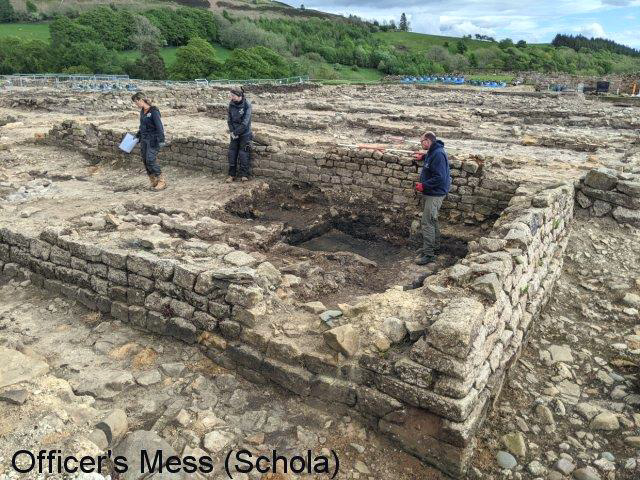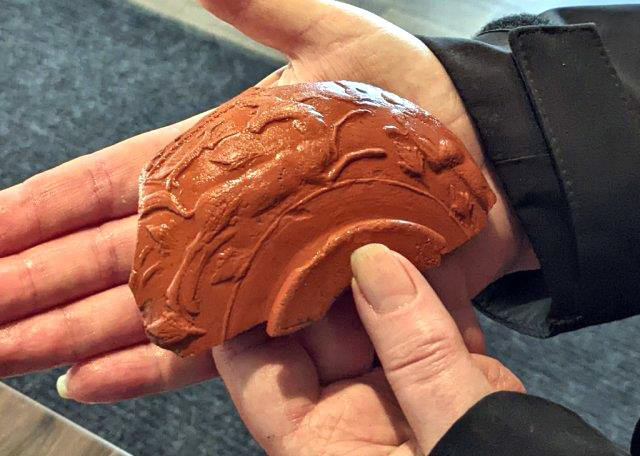
Taking a break from our excavations in Aspull, I managed to book a two-week period on this celebrated Roman site which lies just south of Hadrian's Wall. Some of our members have already had the experience and a couple are regular attendees but this is my first time. I would recommend it to anyone as it was quite an experience. Beware though, a reasonable level of fitness is required as the work is quite intense. This is not just from the digging and the spoil removal (spoil heaps are some distance away) but just getting to the site every day can be quite a challenge, as the volunteer's car park is on the other side of a deep valley. However, the rewards make it well worth it as finds recovered are amazing. Mine were quite modest, the best being a sherd with the makers stamp on it. It was great to see others though, pulling out beautiful Samian pieces and even an inscripted stone (the details of this are now on their website, but be warned the translation is quite rude). For my efforts, the best came (as is the way) on the last session of the last day when I uncovered a 2nd century flag floor found lying under a 3rd surface, which lay under a 4th century wall. This unfortunately had to be left for the next set of volunteers to explore in the following two-week period.

Excavations have been ongoing at Vindolanda for 50 years. The latest investigation will end next year and is focussed on the SW quadrant of the current fort, in an area which has previously been unexcavated. There are an estimated 9 phases of construction at Vindolanda, the last dating to the 3rd and 4th centuries which are the structures you see today. The current project though has also uncovered post-Roman structures including 2 churches with Christian artefacts being retrieved. The 4th century is represented by huge cavalry barracks which were built over two enigmatic 3rd century buildings. One of these is believed to have been an officer's mess, known as a Schola. These buildings, in turn, overlie an earlier phase relating to Emperor Septimius Severus' campaigns north of the Wall. At the time this whole area seems to have been covered by stone-built roundhouses, presumably for locally recruited mercenaries. An even more interesting phase lies below this. It dates from the 2nd half of the 2nd century and is known as the Antonine period. Stone wall structures map out the typical layout of a Roman fort but with a much bigger footprint, in fact more than twice the size of the current one. However below this, in some areas, the anaerobic layers are starting to be exposed, where evidence of even earlier forts are emerging. These are the exciting levels that have, in the past, produced the famed organic remains, such as leather shoes and wooden objects, which include the celebrated writing tablets. You can get more details of the current work from their website here. If you fancy volunteering, booking takes place in November but next year they are hope to open the Magna site (Newsletter 231) booking for this'll be in February.
Aspull Ring Ditch Progress
Last month we reported on our success on finding the actual ditch in our first excavated trench - and also our failure to find it in our second. However, the good news is that we have now found it again in our third trench - and gratifying to discover it has a similar profile i.e., in depth and width. We are now able to get an idea of the size of the ring itself. This has been tentatively achieved by taking some 20mm coring samples on the opposite side of the ring from our first trench. This has enabled us to estimate an outer ring diameter of about 43m which is huge for this type of monument. We've also had a visit from Ian Miller from GMAAS who seemed very impressed with our efforts and keen to see what else we can discover. Work is continuing so let me know if you want to get involved - more details as usual on our blog site here.
Next Meeting
Wednesday 1st June - in our new venue, the Real Crafty on Upper Dicconson Street (7.30pm as usual). This month our chairman Patrick has volunteered to give us a talk on his favourite Roman archaeological site i.e., the Eternal City itself. Entitled Fora and Fana (Monuments and Temples of Ancient Rome), it's a talk I gave in 2009 but has been updated with new material and images. Also, with Patrick's added knowledge and expertise, it's bound to be a much more entertaining prospect. Hope to see you there B.A.
|



